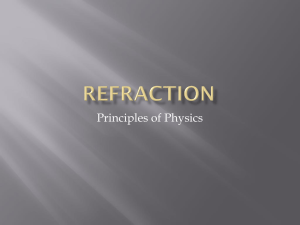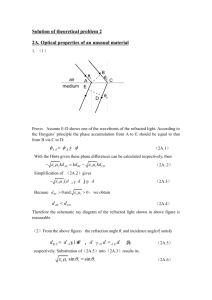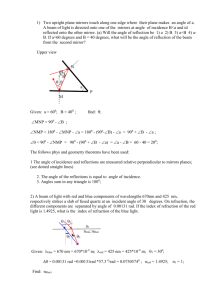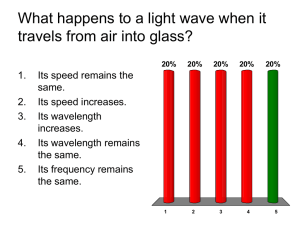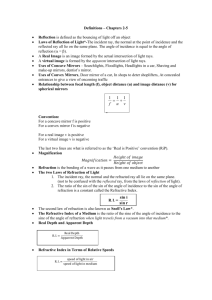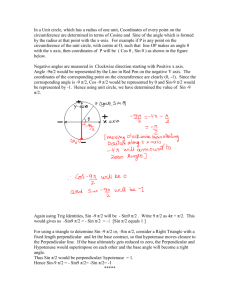WAVE THEORY
advertisement
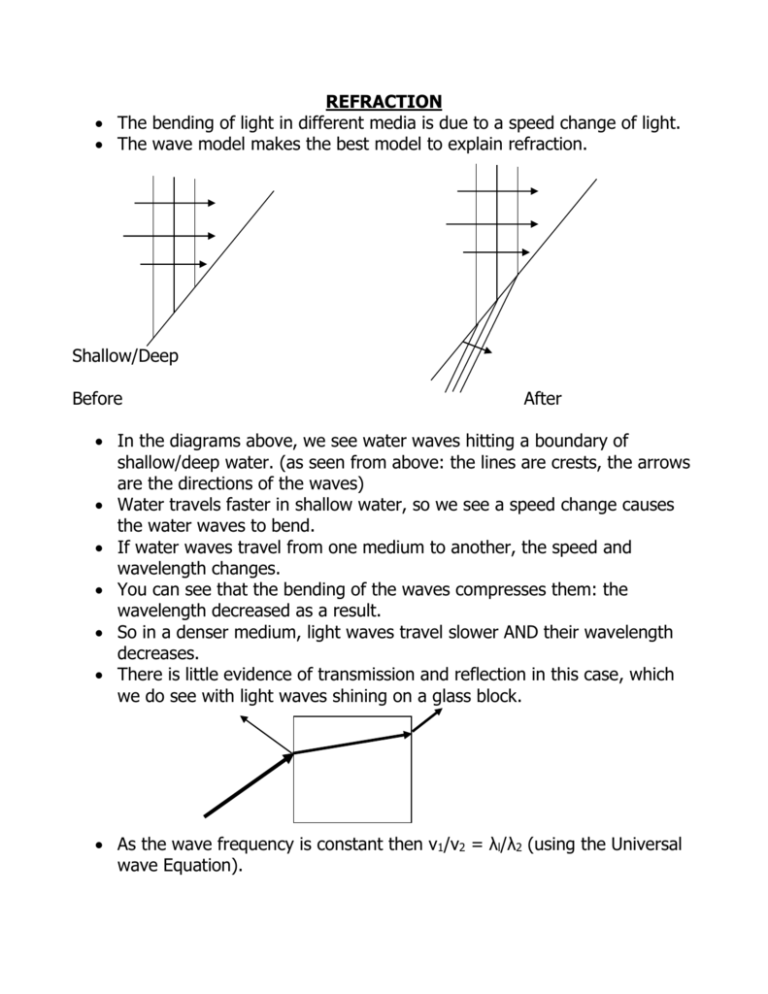
REFRACTION The bending of light in different media is due to a speed change of light. The wave model makes the best model to explain refraction. Shallow/Deep Before After In the diagrams above, we see water waves hitting a boundary of shallow/deep water. (as seen from above: the lines are crests, the arrows are the directions of the waves) Water travels faster in shallow water, so we see a speed change causes the water waves to bend. If water waves travel from one medium to another, the speed and wavelength changes. You can see that the bending of the waves compresses them: the wavelength decreased as a result. So in a denser medium, light waves travel slower AND their wavelength decreases. There is little evidence of transmission and reflection in this case, which we do see with light waves shining on a glass block. As the wave frequency is constant then v1/v2 = λl/λ2 (using the Universal wave Equation). The refracted waves bend towards the normal, as does the ray indicating their direction. Light behaves the same way: so the wave model works well to explain refraction. A constant "n" is the result of the ratio of the two speeds (or the two wavelengths). With light, the index of refraction “n” is the ratio for the speed of light in a vacuum (or air) to the speed of light in the medium. n = c/v 8 c = 3.00 x 10 m/s (the speed of light in air/vacuum) Ex.1) What is the index of refraction for a material when the speed of light in that material is 1.50 x 108 m/s? n = c/v n = 3.00 x 108 m/s 1.50 x 108 m/s = 2.00 The angles that the rays make to the Normal line also indicate some geometry that is useful. N i R n1sini = n2sinR Snell's law for refraction. The subscripts 1 and 2 refer to the 2 mediums the light travels through. 1 is the medium it’s leaving and 2 is the medium it enters. The higher the index of refraction, the more it will bend AND the more it will slow down. The index of refraction "n" indicates the amount of bending a wave will undergo, a constant for each medium. (nwater = 1.33, ndiamond = 2.42) Ex1) A light ray travels from air (n = 1.00) to water (n = 1.33). If the angle of incidence is 30.0 degrees, what is the angle of refraction? n1sini = n2sinR 1.00 x sin 30.0o = 1.33 sin R (1.00 x sin 30.0o)/1.33 = sin R sin-1(1.00 x sin 30.0o/1.33) = R 22.1o = R Higher frequency light waves (like violet) are refracted more than the smaller frequencies (like red). This accounts for why see a prism bend white light into its colours. The wave model does not account for frequency differences. Note: “n” also indicates how optically dense a material is. (The higher the “n” the more it will slow down light.) Particle Model Newton’s physical system involved a set of parallel planes at different heights joined by a ramp and a steel ball. He rolled the ball down the ramp and its path bends towards the normal as light does when entering a denser medium than the one it left. He concluded that the ball enters a denser medium as it hits the ramp, bends towards the normal and would also speed up (because of gravity)!! Notice that the sphere's path bend towards the normal line. The angle of refraction is smaller than the angle of incidence. The mathematical relationship is sini/sinR = constant. Newton's particle model has an incorrect constant, but it is a constant with light so the formula as it stands is correct. Einstein has shown that the speed of light is the fastest speed possible. The idea that light speeds up in a denser medium not only does not make sense intuitively but violates Einstein’s laws. The particle model therefore fails to accurately predict the speed changes but does show the correct bending of light. Critical Angle and Total Internal Reflection We know that when light enters a denser medium it bends towards the normal. N Air Water What happens if light enters a less dense medium than what it travelled from? The light ray bends AWAY from the normal if the medium it enters is less optically dense than the medium it travelled from. If we increased the angle of incidence, the corresponding angle of refraction gets bigger too. N N i i Water Water R Air R Air At a critical angle of incidence (ic), the angle of refraction is 90 degrees (to the Normal line) so the ray skims along the surface! N ic Water R = 90o Air What happens then, if the critical angle is exceeded? N > ic r Water Air Total Internal Reflection. (TIR) The light ray bounces and obeys the Laws of reflection (i = r). Snell’s Law indicates the solution as well. Ex 1) Find the critical angle for Lucite glass (n = 1.60) for an air/Lucite glass boundary. We know for the critical angle, it must travel from more dense to less dense. So we know the light ray travels from Lucite glass into air, in this case. We also know the angle of refraction is 90o for the critical angle. n1sini = n2sinR 1.60 sin ic = 1.00 sin 90o Sin ic = (1.00 sin 90o)/1.60 ic = sin-1[(1.00 sin 90o)/1.60] = 38.7o Ex2) Using the information from Ex 1), determine what occurs when a beam of light travels from Lucite into air when the angle of incidence is 45.0o? We know that we should get TIR now as the angle of incidence is greater than the critical angle. Try Snell’s Law to see what happens: n1sini = n2sinR 1.60 sin 45.0o = 1.00 sin R (1.60 sin 45o)/1.00 = Sin R sin-1[(1.60 sin 45.0o)/1.00] = R R= error The error indicates refraction does not occur but rather the ray REFLECTS. The proper conclusion here is that the ray reflects back into the Lucite at 45.0o. Applications: fibre optics uses the TIR of light to make light travel in a “wire” and to even travel around curves, etc. The diagram indicates light undergoing TIR every time it hits the surface. The light can not escape if the right material is chosen.
